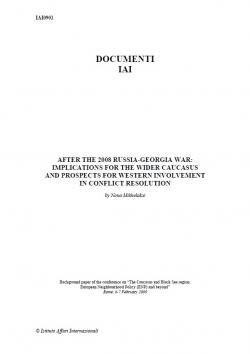After the 2008 Russia-Georgia War: Implications for the Wider Caucasus and Prospects for Western Involvement in Conflict Resolution
The article will analyse new realities in the Caucasian-Caspian region emerged after the August war by tackling the following issues: the current political landscape in Georgia and new developments around the secessionist conflicts; implications for some Central Asian countries in defining their foreign policy priorities; the Turkish proposal for a Caucasus Stability and Cooperation Platform and the Declaration between Azerbaijan, Armenia and the Russian Federation; and tensions in the North Caucasus. The argument is not that developments in the wider region are the direct product of the Georgian-Russian war, but rather that this conflict opened the door to more demands for independence and thus new challenges for neighbouring countries and the international community. Before the Russian-Georgian war the question was whether the West and in particular the EU could or should play a more significant role in the South Caucasus. The urgency of the crisis and its implications has turned that question into how the EU and the US could engage with the region more intensively. Strengthening Euro-Atlantic policies in the Caucasus requires a redefinition of a strategy not only towards the eastern neighbourhood but also towards Russia. Many European states share with Russia common interests and thus are not willing to sacrifice these even at the cost of further destabilization in the South Caucasus. In this context, this article analyses the limits and leverages of the international community to handle together with Moscow conflict issues in the Caucasus.
Background paper of the EU-CONSENT conference on "The Caucasus and Black Sea Region: European Neighbourhood Policy (ENP) and Beyond", Rome, 6-7 February 2009. Subsequent version: After the 2008 Russia-Georgia War: Implications for the Wider Caucasus, in The International Spectator, Vol. 44., No. 3 (July-September 2009), p. 27-42.
-
Details
Roma, IAI, January 2009, 25 p. -
In:
-
Issue
09|01
Introduction
1. Georgia after the August war
1.1. Domestic political developments
1.2. Developments around the secessionist conflicts
2. The wider Caucasus after the Georgian-Russian crisis
2.1. The Caucasian-Caspian region
2.2. New initiatives and developments in Caucasian conflicts
2.2.1. The Turkish Caucasus Stability and Cooperation Platform (CSCP)
2.2.2. The Declaration by Azerbaijan, Armenia and the Russian Federation
2.3. Tensions in the North Caucasus
3. EU and US engagement with the South Caucasus: limits and leverage towards Russia
3.1. Limits to Western leverage towards Russia
3.2. Potential courses of EU action
4. Conclusions
Annex
References
Topic
Tag
Related content
-
Publication18/08/2015
After the 2008 Russia-Georgia War: Implications for the Wider Caucasus
leggi tutto -
Ricerca02/11/2014
Wider Europe, deeper integration? “Constructing Europe” Network – EU-CONSENT
leggi tutto



